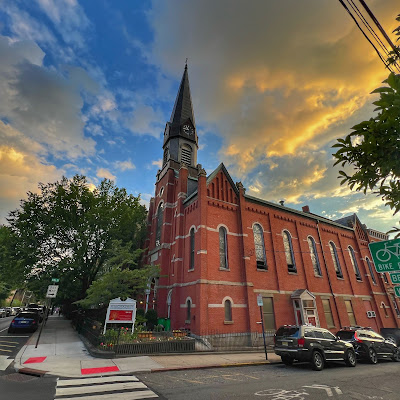I found many references to the poet on the website and recent event invites from The Poetry Society of New York. They even sell a Frank O'Hara t-shirt.
Then, last night, I participated in an online workshop, led by New Jersey poet Michael Paul Thomas (you can find information about his future workshops... highly recommended... at his LinkedIn or by following him on Eventbrite).
Out of nowhere, Frank appeared.
Michael read from O'Hara's New York City "Lunch Poems," as he led us through writing and revision exercises. He based the discussion around how we develop a consistent practice in creative work.
"Do we always have to wait for lightning to bolt down our arm to the pen?" he asked, then answered with a description of O'Hara's practice of writing a poem a day during his lunch hours in the city. He simply described the world around him, then leveled it up with a poetic twist.
Michael urged us to write what we saw around us last night. So I did, and I've revised it a bit today.
I offer this poem to you, Frank, in Blogger's best typewriter font. I beg you to accept it.
Now, please stop haunting me.
---------
A Toast to Frank O'Hara on This Winter’s Solstice
I’m sitting in a house that would otherwise be abandoned.
It’s my grandparents’ old home,
Which is still oddly filled with warmth
On this cold night in western New Jersey.
When I was a boy I would walk to the open field in the side yard
And gaze at the stars: the only source of light,
Save for the glow of the house and the headlights
Of a lone, lost, angry traveler bound for Pennsylvania.
Tonight, that sleepy country road is a four-lane highway.
From the upstairs bedroom window, I see spotlit car dealerships
Displaying comically large American flags across what is now Route 46.
The back road used to border acres of farmland.
Now, it provides access to the busy warehouses that replaced the farms,
And to the back entrance of TD Bank, whose garish green signage glows
Past the bones of the barn where Nonno used to keep chickens and a cow.
In the backyard, a cell tower looms over the ghost of a small orchard,
Which Nonna used to tend to make homemade wine.
Now, there’s a holiday-lit brewery among the back-road warehouses.
The hour is too late to talk to the Sun. When I look to the heavens,
Now, I am surrounded by ever-changing, earthbound constellations.
The stars have fallen from the sky,
And darkness envelops me from above.


















